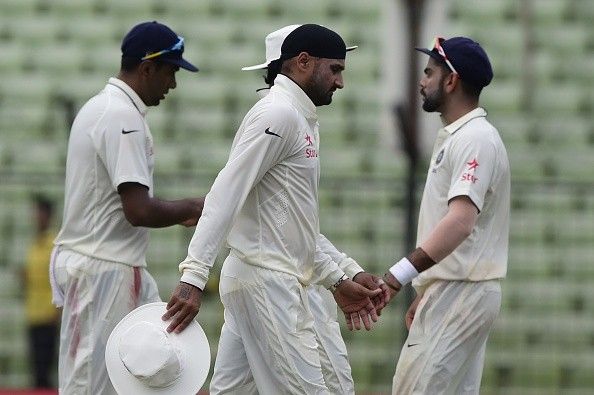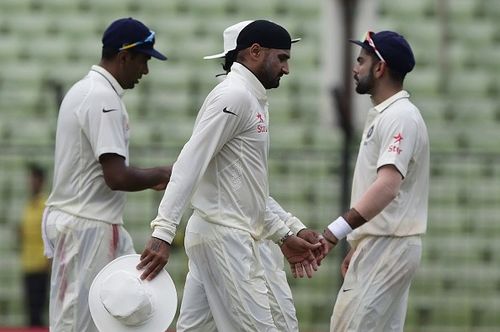
Why India should not go overboard with strengthening their spin bowling for the Lanka series

So, Rama has arrived with his troops in Lanka for yet another shot at conquering the Ravana ruled Lanka. 22 years, it has been, since his army conquered Sri Lanka in a test series in the island. So much has changed since then.
Arjuna Ranatunga who was the captain then, is running for a place in the parliament in the upcoming general elections. Chandika Hathurusinghe, who opened the batting for Sri Lanka in that series, is the head coach of the rampant Bangladesh. Jayananda Warnaweera, one of the two spinners in that side, is currently the curator of the Galle stadium and Pramodya Wickramsinghe, Sri Lanka’s new ball bowler, is just done with an average career as a national selector.
Not just the personages, even the ethos and the milieu have undergone dramatic changes. The war that was terrorizing the north is no more. The economy has become greener as have some of the cricket pitches. There are four more new stadiums in the country. And among all, two great men have begun and almost completed their phenomenal careers.
Amidst the surplus of changes and myriad of makeovers, one thing that seems incorrigible is the semblance of spin that the tracks in Sri Lanka engender. Or should I call it a pretentiousness? The same pretentiousness that makes alien fans think that Sri Lankan tracks are as flat and batsmen friendly as the turfs in the rest of South Asia? The same pretentiousness that makes them belittle the gargantuan numbers of batsmen on these not-so-batsmen friendly tracks?
There was a time when there was more sand in the Sri Lankan pitches than in those late-night trucks that wallow by the Mahaweli- meaning great sandy- river in Sri Lanka to smuggle the obvious. Gone are the days when Sri Lankan pitches had less green than the green in Africa’s Sahara.
Spinner's paradise? Think again
The north of Sri Lanka has almost freed itself from the minefields that were seeded during the war; so have our cricket pitches. And just like the country’s economy, the pitches have become harder and firmer. The myth about slow, low, turning tracks of Sri Lanka have become as old as the construct of nationalism. Sri Lanka has moved on.
Among all the talks of India playing five specialist bowlers and a triplet of spinners, one should never ignore the drastic changes the tracks in Sri Lanka have undergone. The pitch in Pallekele is being touted to be Asia’s Gabba and the track in P. Sara Oval has almost become the West’s favorite hunting ground.
Yes, the spinners have fared well in Sri Lanka and have won them matches. It is easy to believe so, since the truth that belies that fact has been out of reach for many- much like the internet in the island.
In the last four years, Rangana Herath has picked up more wickets than everyone else in Sri Lanka, hence, we can easily resign ourselves to the fact that any spinner can thrive in the shores of Lanka, but lest we forget, let me retell the stories of his performance in Durban in South Africa, Sydney in Australia and Lord’s in England. He is a spinner who relies more on guile than spin; on astuteness than turn. He is a sorcerer who excels in necromancy. Hence, too much cannot be read into his figures in Sri Lanka.
Nonetheless, his own efficacy was put into question and was later swatted away along with his place in the side in the recent Test series against Pakistan. The home side pulled all the stops like a dog venturing to cop its tail to avert Pakistan from successfully hunting down a mammoth 377 on the last two days of that Test match.- an effort in vain. Sri Lankan tracks hardly turn square these days, as would the elevation of Dammikka Prasad, a hit-the-deck fast bowler, into the leader of the bowling pack would suggest.
Stats don’t lie
In the last four years, only Rangana Herath has a jaw-dropping bowling average among spinners from Sri Lanka. He averages 21.93 in Tests while Dilruwan Perera has a decent average of 28.86. Other than this duo, the rest have an underwhelming average. Suraj Randiv has averaged 35.22 in 8 Tests while Ajantha Mendis has an average of 130.
Overall, spinners have averaged 32.45 in the island in the last four years, whereas the pacers have picked up a wicket for every 35.16 runs. The difference is only 2.71 and that does not say much, especially in the Asian context.
Moreover, in the last four years, the visiting spinners have averaged 38.73 with the ball, while the pacemen boast of an average of 30.33. Fast bowlers have also snatched more wickets than spinners, with them picking up 163 wickets as opposed to the spinners’ 126 wickets. In the six matches the visiting teams have won, the average of fast bowlers further sinks low reaching 21.43 with 71 wickets. The spinners of the visiting teams average 28.76 in wins with 47 dismissals.
When the visiting bowlers are ranked according to their averages, fast bowlers occupy the first five spots. Tim Southee has been the best with an average of 13.83 while Ryan Harris, Trent Boult, Morne Morkel and Dale Steyn average 14.54, 15.11, 16 and 17.46 respectively. The spinners, meanwhile, have failed to match the pacers with only Yasir Shah having an average below 20 (19.33). Barring him, the only other spinner who has done well is Graeme Swann, who has an average of 22.18.
Saeed Ajmal, of all the spinners, averages only 33.40. Imran Tahir has an average of 84 and Abdur Rehman averages 52.10. Zulfiqur Babar of Pakistan has done ‘comparatively’ better with a wicket coming every 36.50 runs.
Pace is the way to go
When Australia won Sri Lanka in Galle, in 2011, the pacers picked up 13 wickets while the lone spinner managed only 6. The fast bowlers picked up 17 wickets for New Zealand when they humbled the home team in P Sara Oval in 2013. South African tearaway fast bowlers would pick up 16 wickets among themselves when they derailed the Sri Lankan locomotive in 2014 in Galle. In the recently played match in Kandy, Pakistani seamers picked up 11 wickets to help the visitors register a resounding win.
An argument that can be used to counter this is that Yasir Shah had a very successful tour to the island, picking up 24 wickets in the three Test match series. However, one needs to look into how he got those wickets to know how successful he was as a spinner. Out of the 24 wickets he picked, 7 of them were that of tail-enders. Off the remaining 17 wickets, only 9 of them were earned by the bowler. The remaining eight were the results of poor shots which arose as a result of the pressure exerted by the Pakistani bowling unit as a whole.
It is not that the Sri Lankan batsmen found tackling the turn of Yasir Shah or the variations of him tough. Only 6 wickets fell to sharp turn. Only one batsman misread a googly from him. It was tight accurate bowling that resulted in most of Yasir Shah’s wicket. A constricted field and pin point bowling, dried up runs and the batters got out playing bad shots to break the shackles.
The aforementioned facts show that to win a Test in Sri Lanka, a team needs more than just good spinners. In fact, having a state-of-the-art fast bowling unit becomes imperative. India will be playing their Test matches in Galle, P Sara Oval and SSC. Even though no team has managed to win Sri Lanka at SSC in the last four years, Sri Lanka has lost 3 Tests at Galle and 2 in P Sara Oval in the last four years.
In the three wins for the visitors at Galle, pace bowlers have averaged 19.17 and spinners 27.48. Wins for foreign teams in P Sara have chiefly been architectured by pace bowlers with them picking up wickets at an average of 19.3 while spinners have an average of 35.23.
Amit Mishra can wait
Both England and New Zealand have exploited the bounce and seam on the P Sara track. Galle assists reverse swing on day 4 and 5. The first day in SSC has regularly been dominated by fast bowlers. Hence, India will need their fast bowlers to step up, if they are to win the Test series against Sri Lanka.
If India decides to field 5 bowlers as they did against Bangladesh, then, they need to make sure they play three seamers and only two spinners. India should not get carried away by the prospect of turning tracks in Sri Lanka.
Spinners, naturally have the ability to bowl longer spells and greater number of overs. However, fast bowlers will need a lot of rest in between spells and may not be able to bowl longer overs, since the heat in Sri Lanka can sap into their energy. Both Ravichandran Ashwin and Harbhajan Singh can share the workload of spinners but two fast bowlers are unlikely to provide India the much needed menace.
The pitch in Premadasa would have insinuated India about what could be on offer for them in Sri Lanka. The nature of Sri Lankan pitches have changed drastically over the time and India should not plan against Sri Lanka with what had come to pass in the last decade in mind. The visitors need to make sure that they are not intrigued by the sham of turning tracks in the island and should instead plan to vanquish the home team with their fast bowlers.